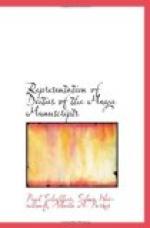Seler thinks he recognizes in some of the figures represented under H’s hieroglyph in the manuscripts, a so-called “young god”. Such a deity is unknown and the assumption is entirely arbitrary. Apparently this “young god” is an invention of Brinton. The purely inductive and descriptive study of the manuscripts does not prove the existence of such a personage, and we must decline to admit him as the result of deductive reasoning. In this so-called “young god”, we miss, first of all, a characteristic mark, a distinct peculiarity such as belongs to all the figures of gods in the manuscripts without exception and by which he could be recognized. Except his so-called youthfulness, however, no such definite marks are to be found. Furthermore there is no figure of a god in the manuscripts which would not be designated by a definite characteristic hieroglyph. No such hieroglyph can be proved as belonging to the “young god”. The figures, which are supposed to have a “youthful appearance” in the Madrid manuscript, often convey this impression merely in consequence of their smallness and of the pitiful, squatting attitude in which they are represented. Furthermore real children do occur here and there, thus, for example, in the Dresden manuscript in connection with the pictures of women in the first part and in Tro. 20*c in the representation of the so-called “infant baptism.”
That god H has some relation to the serpent must be conjectured from what has been said. Thus, for example, on Dr. 15b, we see his hieroglyph belonging to the figure of a woman with the knotted serpent on her head, in Dr. 4a to the god P, who there bears a serpent in his hand, and in Dr. 35b in connection with a serpent with B’s head. What this relation is, cannot now be stated.
The day dedicated to god H is Chicchan, and the sign for this day is his distinguishing hieroglyph.
I. The Water-Goddess.
[Illustration: Fig. 41]
In the Dresden manuscript the figure of an old woman, with the body stained brown and claws in place of feet, occurs repeatedly. She wears on her head a knotted serpent and with her hands pours water from a vessel. Evidently we have here a personification of water in its quality of destroyer, a goddess of floods and cloud-bursts, which, as we know, play an important part in Central America. Page 27, of the Codex Troano contains a picture, in which this character of goddess I may be distinctly recognized. In accordance with this character, also on Dr. 74, where something resembling a flood is represented, she wears the cross-bones of the death-god.




